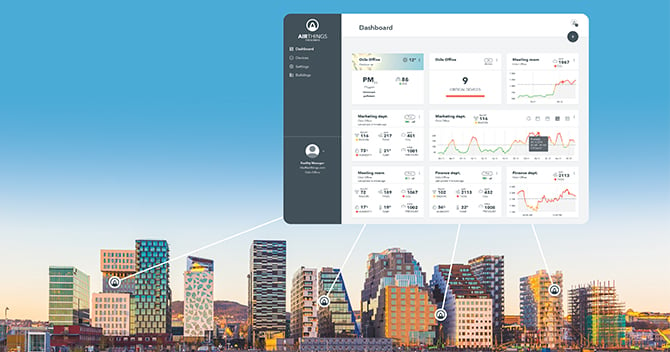Data isn’t just for techies; it can help FMs work smarter and better too, with improved efficiency, lower costs and happier tenants
We frequently hear in the media that vast quantities of electronic information are changing industry, education, and even politics. The biggest economies are jostling to gain a competitive edge in this area and the Cambridge Analytica controversy dominated coverage of recent elections.
Discussions about the data revolution are all around us, but it can seem like something that’s only relevant to data scientists and high-tech Silicon Valley types. Yet, smart technology and analytics are rapidly transforming the way we think about facility management. The latest digital solutions gather facilities management data and turn it into useful insights, enabling FMs to work smarter, identify possible problems before they arise, and cut costs by maximizing efficiency in their buildings.
Using data effectively needn’t involve mastering statistics or complicated algorithms. The best systems will present all the information you need in one place, so you have an in-depth understanding of issues in your facility and can take action quickly or even automatically. But what does all of this mean for the day to day running of facility management operations?

A central hub makes it easy to access data that’s been pulled in from monitors and sensors across your site. Indoor air quality is a key metric that can be used to boost building efficiency, enhance productivity, and attract new tenants.
Indoor air quality monitors measure harmful pollutants like radon, volatile organic compounds (VOCs), and carbon dioxide, as well as indoor conditions like humidity, temperature, and atmospheric pressure. Build-ups of harmful gases can affect building users’ productivity, as well as damaging their health, while environmental conditions impact how effectively people work or learn.
By monitoring this data, and accessing useful information through a central hub, you can anticipate any issues that may arise, before the client calls. FMs also know that temperature can be a matter of contention in many offices, with a range of different preferences and a large amount of subjectivity about whether it feels too hot or too cold. With the facts at your fingertips, these disputes can be defused before they get out of hand, by establishing acceptable temperature ranges and tracking it in real time.
Evidence at your finger-tips

Routinely, FMs are asked to manage an expanding range of responsibilities, often while dealing with tight budgets. When you discuss making changes in your building, conducting maintenance, or installing new equipment, you’ll be required to provide evidence that the work will produce worthwhile results.
Indoor air quality monitors may reveal a need for better ventilation in your facility and, if that’s the case, a hub system makes it easier to isolate the supporting data and present it in a way that’s easy to understand. Access all the information you need in one place, rather than checking each system individually.
By starting a conversation about optimizing conditions in your building, and boosting productivity among users, you can show the true value of your role. The job’s not just about managing problems and fire-fighting. It involves getting the most out of the facility and providing a healthy return on investment. Facilities management data is a key part of this.
Equally, air quality monitoring may reveal when existing ventilation equipment is beginning to fail or maintenance is required. Perhaps radon levels are rising because of cracks in the foundations, or windows are becoming difficult to open. With the relevant data to hand, you can be proactive about fixing issues before they create a headache for building users.
Smarter management of time and resources

A key part of an FM’s job is deploying maintenance staff where they’re needed and making sure the right person is sent to get the job done. Indoor air quality monitoring makes this easier, by providing relevant information about indoor air issues and alerting you to problems as soon as they arise.
With a central Hub, you can access an overview of air quality in all rooms, floors, and locations. It’s possible to set-up automated alerts that send notifications to your mobile device when conditions change or deteriorate.
Rather than wasting time investigating the issue, you’ll have the data you need to send the right person to fix the problem immediately, saving time and money in the longer-term. Indoor air quality data helps you plan and prioritize your jobs list more easily.
Reducing costs and responding to occupancy rates
Leading indoor air quality solutions feature tools that help you analyze energy usage and monitor occupancy so that you can adjust your heating and ventilation systems accordingly, use lights more efficiently, and minimize the time that other appliances are active.
Building management systems (BMS) and Integrated Workplace Management Systems (IWMS) can be integrated with indoor air monitoring solutions. By using sensor data to trigger heat, ventilation, and light only when they’re needed, you can ensure better use of your workspace and cuts costs significantly.

It’s also possible to monitor occupancy by measuring CO2 and tracking changes over time. One company saved time and money by canceling a plan to build new meeting rooms, once they looked at occupancy data and realized the existing rooms were under-utilized. This saved them $5.6 million.
With the clever use of occupancy information, it’s possible to save on cleaning costs by factoring in usage and deploying staff only when and where they’re needed. If employees arrive at a particular office early you can schedule the cleaners to clean there first. Alternatively, if there are fewer people at work on Fridays in a particular site, it could make sense to cancel cleaning that afternoon.
Perhaps you’re fielding complaints from clients about the availability of meeting rooms. Occupancy data will highlight if rooms are being booked, but not being used. You can also improve retail and catering profitability. For example, you could provide the insights to allow for optimized stocking of the cafeteria, in line with likely demand. This would be based on real-time occupancy data. If fewer people have lunch on a Mondays or Wednesdays, then you can request that the caterers prepare less food.
Occupancy data helps you understand in detail how your building is being used. By utilizing this information to guide your management decisions, you can get the most out of existing space, which is helpful when you are scheduling services across a number of buildings.
Staying on top of compliance

Regulators are steadily turning their attention to the quality of indoor air, as its importance for public health is more clearly understood. In the US and EU, new guidelines have been drawn up to ensure safe levels of radon in workplaces and the World Health Organization (WHO) is encouraging governments to take action on a range of pollutants.
Facilities management data can help here too. With indoor air quality monitoring, it’s easy to access historical data and reporting to prove compliance. This might involve retrieving information on radon as part of real estate laws, or complying with building codes on ventilation. It could be part of an indoor air quality plan developed to gain a facility BREEAM certification.
With Airthings for Business, the necessary data can be viewed through the dashboard and turned into PDF reports with the push of a button.
Data helps you do a better job and makes your life easier

It’s tempting to think of data as a form of wizardry that only a privileged caste of techies can master and understand. However, increasingly, we have the tools to make sense of raw information and turn it into insights and action. With the right system and the right analysis, data makes it easier to do your job, and do it well.
For facility managers, indoor air quality is a way of gathering information conveniently and turning it into something useful that helps with day-to-day work. It enables better planning, assists with cost reduction, and ensures you’re getting the most out of your building. Importantly, it also provides a clear demonstration of what an important job you do.
Key takeaways
- Smart use of data makes facility management easier and helps FMs to do a better job.
- With Airthings for Business, your data is gathered in one place and turned into user-friendly insights.
- Indoor air quality data gives you evidence to action work orders, conduct maintenance, or make changes in your building.
- Automatic notifications will flag up any problems with indoor air quality or pollutants, allowing you to send the right person to tackle the issue.
- Monitoring CO2 can be used to analyze occupancy rates, meaning that energy costs and staffing costs can be cut, and any production can be closely matched to demand.

 Most popular
Most popular
 NEW
NEW




 Radon
Radon
 Radon
Radon









